In the heart-wrenching depths of human trafficking, Nepal stands as a battlefield where the vulnerable are ensnared using social media. Social media, once a beacon of connectivity, has become a powerful weapon of destruction in the hands of traffickers.
The grim impact of social media on Human Trafficking is becoming increasingly undeniable.
Social media platforms have become the hunting grounds where traffickers exploit vulnerabilities, leaving devastating consequences in their wake. While it is important to note that social media platforms themselves are not directly responsible for trafficking, they can be exploited by traffickers due to their wide reach, accessibility, and limited regulation.
Recruitment and grooming are easily achieved over these platforms. Traffickers use social media platforms to identify and approach potential victims. They may create fake profiles or pose as someone else to gain the trust of vulnerable individuals, especially young people. Through manipulation and coercion, traffickers can groom victims and initiate the trafficking process. Within the virtual realms of social media, traffickers easily infiltrate the lives of those desperate for hope. Vulnerable individuals seeking brighter futures, employment, or education are mercilessly targeted, as traffickers exploit their desperation and circumstance and seek to exploit them in the evilest of ways.
The greatest asset to a trafficker is the anonymity offered by social platforms. Traffickers easily mask their intentions in a web of deceit strategically spun to capture the victim.
Often masquerading as saviours, while concealing their identities, these false personas grant them access to unsuspecting victims. Their intentions are hidden behind seemingly harmless and positive private conversations that are hidden from the eyes of concerned family members or law officials. Traffickers gain direct access this way to the innermost spaces of some of society’s most vulnerable.
It isn’t long before what started as seemingly innocent turns ugly. Within the private recesses of social media platforms, traffickers engage victims in insidious conversations, wielding emotional control as their weapon of choice. They subtly manipulate hopes, dreams, and fears, using deceptive promises, all the while maintaining a cover that remains undetectable.
We see so many cases that follow this format. Take the recent case of Baani.*
Born and raised in rural Nepal, Baani * experienced profound loss at a young age when both her parents passed away. Left without proper care, she found solace in a compassionate brother figure who embraced her as his own sister. She worked at the hotel he ran to contribute to their livelihood.
Lonely, Baani connected with a man through Facebook, eventually leading to a relationship and hasty marriage. A few months after their marriage, the couple were regularly fighting. Coercion and physical abuse became the norm within their marriage, pushing Baani to breaking point. Things escalated and one day culminated in her husband along with his friends, trying to physically, and forcefully transport Baani to India.
Baani fought back and managed to get away. She went back to her brother’s workplace and started working there again. Life settled down for Baani briefly.
Then one day, out of the blue, as Baani travelled to work, her husband and his friends attacked her, forcing her to comply. They took over control of the bus she was on and transported her to the border. Overwhelmed and frightened Baani knew she had to do something. Seizing an opportunity as the bus stopped briefly, Baani escaped and took shelter at one of our booths located in the area.
Police were called to investigate. Unfortunately, the men escaped custody, but the case continues to be investigated. With the support of our staff, Baani was able to reconnect safely with her family and remains under the care of our follow-up team.
In Baani’s case the assailant went as far as to marry her. By learning about her through her social media pages to win her trust, he then exploited her.
It’s not just in obtaining control of a victim that traffickers benefit from on these platforms. Social media allows traffickers a platform to market their products. They can easily create posts or profiles promoting exploitative activities, such as forced labour or sex trafficking. Traffickers can reach a large audience quickly and discreetly, making it challenging for authorities to detect and prevent such activities. These platforms also allow for ease of networking for perpetrators. Networking and coordination through social media allows traffickers to connect with each other, forming networks and sharing information on how to operate undetected. They can exchange tips, and strategies, and even collaborate on trafficking schemes like the attempted sale of Baani into slavery. These online communities provide a support system for traffickers and contribute to the perpetuation of their criminal activities.
Social networks give predators easy access to the most vulnerable of society as seen in the recent rescue of three young Nepali girls aged 15, 15 & 14 years who were intercepted at the border just moments before they became trafficking victims. Asha* 15 was orphaned at age 5 and taken in by her elderly impoverished grandfather.
She dreamed of a better life and had heard that work in Mumbai (Bombay) paid well from a man she had met online through social media. The man ran a hotel and convinced Asha that if she were to come to India, he would be able to give her a job. His only request was that she did not tell anyone and that she bring two friends younger than herself. Asha, completely naïve and desperate for an opportunity to break free from the hardship of her life, jumped at the promise of a salary and good accommodation, Asha and her two friends left for India without telling anyone.
Thankfully the three girls were intercepted on the border, counselled and were able to return to their families, fully aware of the danger they narrowly escaped.
It’s important to acknowledge that social media platforms are actively working to combat human trafficking. They employ various measures, such as content moderation, reporting mechanisms, and partnerships with organizations fighting trafficking, to identify and remove illegal content. However, given the scale and complexity of the issue, ongoing efforts are required from both platforms and governments to minimize the exploitation of social media for trafficking purposes.
Addressing human trafficking requires a multi-faceted approach involving education, awareness campaigns, legislative measures, law enforcement efforts, and international cooperation. So, while efforts are being made in the world of online media platforms, the hands-on work at the border and community education programs continues to be our front-line defence.






